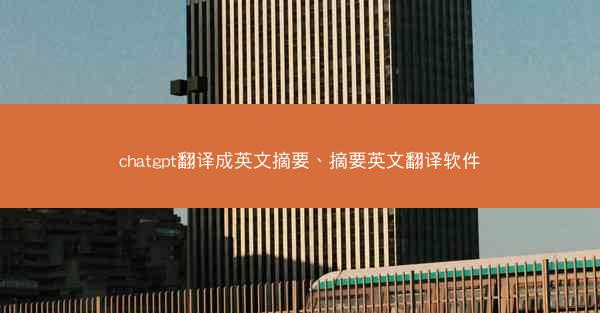Telegram中文版下载
Telegram中文版下载
当前位置:Telegram中文版下载 > 知识教程 > 文章页
-

This article delves into the capabilities of ChatGPT in translating English summaries and the use of software for summarizing English texts. It explores the accuracy, efficiency, and potential limitations of these tools, providing insights into how they can aid in language processing and text analysis.
---
Introduction to ChatGPT and Translation
ChatGPT, developed by OpenAI, is a language model that has gained significant attention for its ability to generate human-like text. One of its applications is in translation, where it can convert English summaries into other languages and vice versa. This capability has made it a valuable tool for those working with multilingual content, offering a quick and efficient way to understand and communicate across different languages.
Accuracy of ChatGPT Translation
The accuracy of ChatGPT's translations is a crucial aspect to consider. While the model has been trained on a vast corpus of text, it is not infallible. There are instances where the translation may not capture the nuances of the original text, leading to potential misunderstandings. However, with continuous improvements and updates, the accuracy of ChatGPT's translations has been steadily increasing. Users should be aware of the limitations and use the translations as a guide rather than a definitive source.
Efficiency in Translating English Summaries
One of the strengths of ChatGPT is its efficiency in translating English summaries. Summaries are concise and to the point, making them ideal for translation. ChatGPT can process these summaries quickly, providing translated versions in a matter of seconds. This speed is particularly beneficial for researchers, journalists, and professionals who need to quickly understand content in a different language.
Applications of ChatGPT in Multilingual Content
ChatGPT's translation capabilities have a wide range of applications in the realm of multilingual content. For instance, it can be used to translate research papers, news articles, and technical documents. This is particularly useful for individuals who do not have access to the original language but need to stay updated with the latest information. Additionally, ChatGPT can assist in cross-cultural communication, breaking down language barriers and fostering global understanding.
Limitations and Challenges
Despite its many advantages, ChatGPT faces several limitations and challenges. One of the primary challenges is the potential for errors, especially in complex or specialized texts. Additionally, the model may struggle with context-dependent translations, where the meaning of a word or phrase can vary based on the surrounding text. Furthermore, the reliance on machine learning algorithms means that ChatGPT's performance can be affected by the quality and diversity of the training data.
Role of Abstract Summarization Software
In addition to ChatGPT, there are various software tools designed specifically for summarizing English texts. These tools use advanced algorithms to condense lengthy documents into concise summaries, making it easier for users to grasp the main points. While these tools can be useful, they often lack the nuanced understanding of human language that ChatGPT brings to the table. As a result, the summaries generated by these tools may not always capture the full essence of the original text.
Conclusion
ChatGPT's translation capabilities, particularly in translating English summaries, offer a valuable tool for those working with multilingual content. While the accuracy and efficiency of these translations are impressive, users should be aware of the limitations and use them as a guide rather than a definitive source. The combination of ChatGPT and abstract summarization software can further enhance the processing and analysis of text, aiding in language learning, research, and global communication. As technology continues to evolve, it is likely that these tools will become even more sophisticated, providing even greater support in the realm of language processing and text analysis.
chatgpt翻译成英文摘要、摘要英文翻译软件
2025-03-16 03:57 分类 : 知识教程
相关文章
- 2025-04-03 10:56ChatGPT各个版本—chatcraftpro下载
- 2025-03-16 10:48y是什么牌子的电脑
- 2025-03-23 15:23电脑怎么登录微信不用扫描二维码
- 2025-03-24 22:44下载老旧版本微信7.0.3苹果
- 2025-03-20 17:11telegram怎么改成汉字
- 2025-04-26 22:50chatgpt国内的是真的吗(chatroulette在中国能用吗)
- 2025-03-17 00:16电报手机号收不到验证码
- 2025-03-17 22:31汉化飞机软件
- 2025-03-23 04:33电脑1tp是什么意思
- 2025-03-17 04:42电脑tgp是什么
-
随机文章
-
最近发表
-
-
热门文章 | 最新文章 | 随机文章
-
Copyright (C) 2025 Telegram中文版下载 Rights Reserved. xml地图
免责声明:Telegram中文版下载所有文章、文字、图片等资料均来自互联网(网络),转载或复制请注明出处。
仅限于参考和学习,不代表本站赞同其观点,本站亦不为其版权负责。如有侵犯您的版权,请联系我们删除。